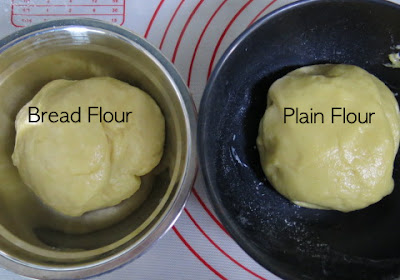Bread Experiments Chapter 2: Brioche Plain Flour vs. Bread Flour
So, I've finally dragged myself down and made myself write this post on the Brioche recipe.
Similar to the last post, I wanted to compare the difference between Plain Flour and Bread Flour.
Here's the basic recipe I used:
120 g flour (plain or bread)
1/2 tablespoon sugar
A pinch of salt
1 teaspoon instant dry yeast
1 small / medium egg
30-40ml whole milk
40g butter, softened
First I put all the dry ingredients together, keeping the yeast far away from the sugar and salt. Then after adding the egg, I added the milk until the dough just comes together. The reason for using a range for the milk is that the moisture needs to be adjusted depending on the size of the egg and the humidity. Then the butter was added last. I continued kneading it until a homogeneous dough formed.
I left it to rise at room temperature for about 1 hour.
This is the plain flour brioche. It looks a bit flatter and somewhat spreads out a bit more. The holes are also more homogeneously distributed.
Texture and taste wise, both breads are almost the same. So again, there is no obvious difference between using plain or bread flour. Perhaps just the rise and the spread of the loaf, the plain flour brioche would spread a bit more.
Hope you've enjoyed this blog. Till next time, see ya!
Similar to the last post, I wanted to compare the difference between Plain Flour and Bread Flour.
Here's the basic recipe I used:
120 g flour (plain or bread)
1/2 tablespoon sugar
A pinch of salt
1 teaspoon instant dry yeast
1 small / medium egg
30-40ml whole milk
40g butter, softened
First I put all the dry ingredients together, keeping the yeast far away from the sugar and salt. Then after adding the egg, I added the milk until the dough just comes together. The reason for using a range for the milk is that the moisture needs to be adjusted depending on the size of the egg and the humidity. Then the butter was added last. I continued kneading it until a homogeneous dough formed.
I left it to rise at room temperature for about 1 hour.
After a second round of kneading and shaping, I left the doughs to rise for 40 mins and preheated my oven until 180 degrees C. After baking for about 20-25 minutes, the brioches are ready.
And it's time to cut through them for the big reveal. First up, the bread flour brioche..
As you can see, the bread flour brioche has some irregular holes, but tends to be a bit compressed at the bottom. It is definitely the texture of bread.
Texture and taste wise, both breads are almost the same. So again, there is no obvious difference between using plain or bread flour. Perhaps just the rise and the spread of the loaf, the plain flour brioche would spread a bit more.
Hope you've enjoyed this blog. Till next time, see ya!







المواد الغذائية Thanks for taking the time to discuss this, I feel strongly about it and love learning more on this topic. If possible, as you gain expertise, would you mind updating your blog with extra information? It is extremely helpful for me. Thanks for taking the time to discuss this, I feel strongly about it and love learning more on this topic. If possible, as you gain expertise, would you mind updating your blog with extra information? It is extremely helpful for me.
ReplyDelete